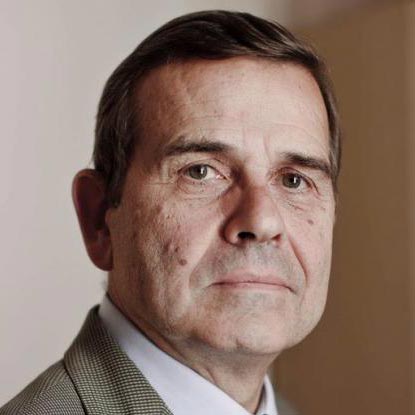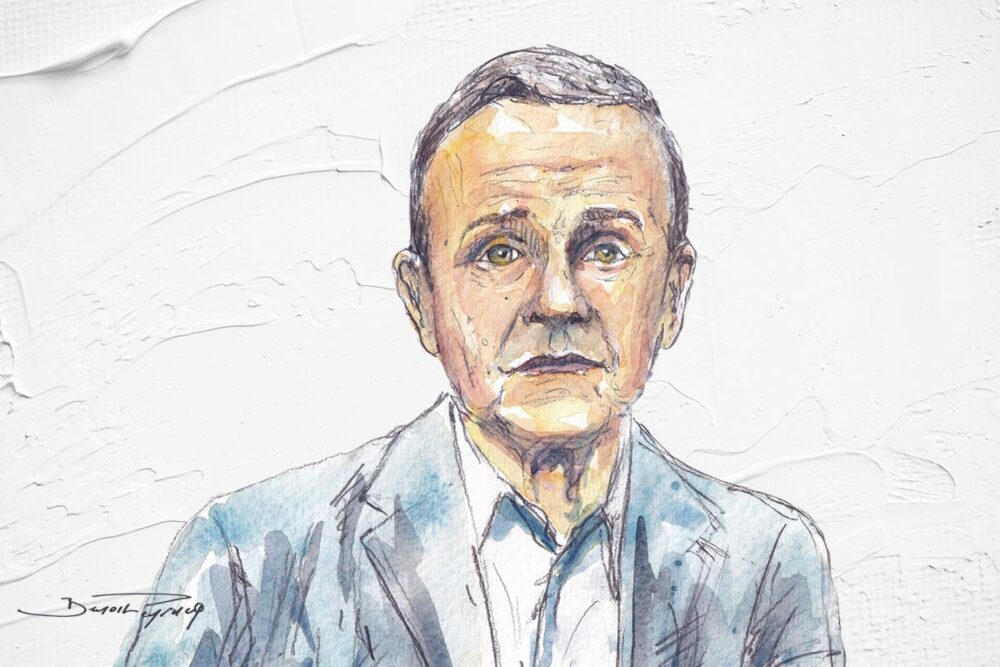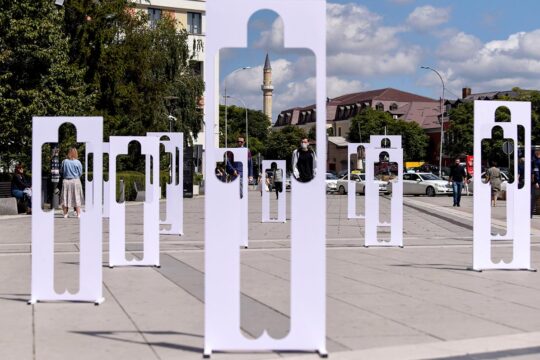JUSTICE INFO IN-DEPTH INTERVIEWS
Antoine Garapon
French magistrate, head of the Recognition and Reparation Commission for alleged sexual violence committed by members of religious institutions
Are restorative processes, like those in France dealing with Church abuse, the future in dealing with crimes that courts cannot judge? This is the plea made by French magistrate Antoine Garapon, who heads the Recognition and Reparation Commission for alleged sexual violence committed by members of religious institutions. He believes that “we now know how to do this”.
JUSTICE INFO: You have just published a book entitled “For a new type of justice – the restorative path”. Why now?
ANTOINE GARAPON: It took me years to write it, because it reflects my career to some extent. I was a juvenile court judge for 12 years, I was very involved in the fight against mass atrocities, and now I have returned to my first love -- if I can put it that way --, working closely with victims as part of the Recognition and Reparation Commission (CRR). I’ve learned from them that they feel guilty. We come across awful cases where people who were assaulted at age 9, 10 or 14 have become adults with great difficulties and feel responsible for what happened to them. This feeling is very widespread among victims of sexual violence. That’s why some of them set about ruining their lives, as if they wanted to punish themselves. Rape is the only crime where the perpetrator feels innocent and the victim feels guilty.
That’s the difference between victim and person who has been wronged. The latter is someone who has been wronged, but who is still intact. The victim is someone who has been completely destroyed by evil. Restorative justice means thinking about justice in terms of the negative ethical experience of the victim, which does not fit into the categories of the law. Hence the idea of this book, which is to think about justice that goes beyond the law and so-called “ordinary” justice.
Why do you feel that criminal justice is ill-suited, or even unable, to respond to “institutional crimes” - committed by political, military, religious or parental agents - which you describe as “perfect crimes”, since the wounds they leave are often neither visible nor possible to prove?
Because it sees the individual as a unit separable from others who has rights to assert, without understanding the very special bond we have with fundamental institutions, be they clerical, parental or political. In the 1960s, Hannah Arendt and Jean Améry provided much insight into this phenomenon, which cannot help but make us think of totalitarianism. This implies that victims’ “recovery” requires their reintegration into the institution. That means more than simply asserting their rights.
Victims of sexual violence feel exiled from the world. They feel cut off from society. Arthur Dénouveaux, a Bataclan victim who heads the Life for Paris association, explains that “all of a sudden, everyone is feeling sorry for us, surrounding us, and at the same time separating us from others. And as it happens, we suddenly can’t find a job...”
Victims demand their rights but also something beyond the law.
Does this mean that these victims no longer believe in justice as an institution?
No, they expect something from criminal justice -- they demand their rights but also something beyond the law. I am thinking of someone whose assailant, a cleric, was sentenced to 15 years’ in jail by a criminal court, but who asked to meet the congregation he belonged to, because she wanted to understand how this was possible, who this cleric was, and if there were other victims. Through the institution, she wants to find a way back into the world. The same is true for incest. As a children’s judge, I saw that girls who denounce incest don’t necessarily want their father to go to prison, but they do want to break an unhealthy relationship.
This involves what you call the “closure meeting”; a meeting between the “victim” and the “perpetrator” which has at the heart of the process the victim, language and speech. Can you explain?
Reintegrating victims into a relationship requires that they have been able to tell themselves and others their truth. They want to look at their abuser without lowering their eyes, so they can disengage and move beyond the trauma. Then they can regain - I was going to say “reoccupy” - a place as a wronged person rather than a victim. The aim, then, is to give them back their voice. They criticize the ordinary justice system for depriving them of this, like when a police officer “takes” (in every sense of the word) their statement; it’s an essential step, because he knows the law and he knows what elements are needed to establish, for example, rape, inappropriate touching or other form of abuse. Then they go to see a lawyer, who will choose a strategy to defend them and insist on certain points. Then they see a psychologist, who will insist on a certain aspect of their suffering. Each time, the victim is deprived of their voice, for very good reasons. They are in the hands of people who take their place for their own good, but who deprive them of any control over the process.
In restorative justice, the spoken word becomes the instrument of justice, because it is the tool of existence and new beginnings.
In restorative justice, on the other hand, the spoken word becomes the instrument of justice, because it is the tool of existence and new beginnings. Every word is a reinstatement of language, and thus a new access to oneself. Recovering one’s voice is a way of regaining control of one’s destiny, of saying “now, I am deciding”. And so this element is central, because it is speech that restores. Moving from being a victim to a witness. Sometimes the next step is for the person to offer their experience, transformed into real expertise, to prevent the recurrence of such crimes.
The next stage is the meeting, which does not necessarily involve direct contact with the aggressor - in fact, this is quite rare. It means that a third party (an association, for example) will make the link with the institution that has assaulted, hidden, denied or ignored the victim. People need to be brought together in a neutral, banal, egalitarian space, a common space that allows them to speak more freely, so that they can then make the closure and live their lives as they wish. That’s the closure meeting. Finally, aggression, like crimes against humanity, has the effect of expelling people from the world, of isolating them; the victim is a stateless person in his or her own country, no longer having a place or the right to have rights. What is justice before it is a virtue? It is a common space.
In your book, you elaborate at length on the philosophical foundations of restorative justice. Can you explain why?
I felt it was important to give restorative justice its philosophical dignity.
For the criminologist Howard Zehr, one of the fathers of restorative justice, this alternative form of justice is a pacified form that would best serve the interests of the accused, the victim and society; a kind of invisible hand that would harmonize and converge all these interests. But, unfortunately, our societies are rife with violence and conflict. The bad is also within us: sad passions and sadistic impulses run through human beings, there are perverted souls and vulnerable people whose destinies intersect, to the misfortune of some. The proportion of perpetrators of sexual violence who are themselves former victims of sexual violence is not well known. Academic Mark Drumbl describes this very well in his article “Victims who victimize”; some behave abhorrently because they have been treated abhorrently. I’m thinking of Dominic Ongwen, a Ugandan child soldier who was abducted on his way to school and then made to do appalling things.
This raises a very profound question: what is the origin of evil? Who started it? We don't know. And that’s what we find in justice. We must dare to confront the question of evil. In the end, reducing everything to the transgression of a law is reassuring, as it allows us to confine ourselves to a “transgression-punishment” relationship. The law has broken evil down into rules, enumerating the behaviours that must not be practised: thou shalt not kill, and so on. In the field of sexual violence, we see a repetition of evil that forces us to think of justice that goes beyond the law, beyond the rules, and therefore also beyond procedure. That was the intellectual challenge of this book. How can we develop concepts for thinking about a “non-juridical” justice system? I was lucky enough to be close to Paul Ricœur for many years, and to meet many intellectuals. They helped me to see what I was perceiving in my different practices. I also learned a lot from children, educators, social workers, psychologists, human rights activists and victims. I’ve always wanted to make the link between a practice, like the one set up within the CRR, and its conceptualization. Justice is a practical art, carried out with intuitions and objectives, but without theory it cannot be justified.
When a victim, who hasn’t had the energy to live for years, talks either to their attacker or, more often than not, to representatives of the congregation of which the attacker was a member, something is reborn.
You postulate that “restorative justice bears within it a new sense of justice, so much are its practices ahead of their conceptualization”. On what pillars does it rest?
I organize this around the idea of “rebuilding a shared world”, as I outlined above. Restorative justice is not as monolithic as an institution, but stems from a series of micro-experiences. It comes into being by organizing a space for the closure meeting I mentioned earlier.
When a victim, who hasn’t had the energy to live for years, talks either to their attacker or, more often than not, to representatives of the congregation of which the attacker was a member, something is reborn. I’m thinking of a woman who, at over 60, said to a CRR commissioner: “Why shouldn’t I spend the end my life with a man?” It’s extremely moving; it means that, all of a sudden it’s possible, I’m capable of being happy with a man, or of making a man happy, I’m capable of giving, sharing and so on. It is a new lease of life. Others join an association, play billiards or do permaculture. Or there’s this man I’ve seen who threw away his walking stick because he didn’t need it anymore. Hence the tone that links justice to life, to the energy of living.
Finally, restorative justice is less interested in guilt, in evidence, in a trial, than in the victim’s innocence. If I give the victim a voice and recognize him or her as a person, as a member of the group that is common space with me, this is a way of restoring his or her innocence. The ultimate aim of this justice is regeneration. So I wanted to put all these notions up for discussion, to give some pointers and to show that justice is not just a “good deed”. Restorative justice addresses the political dimension of justice. It is the very soul of justice.
You also write that it “rests on another form of democracy, that of ‘care’ and responsibility for each other”. What do you mean by this?
Unfortunately, very few victims - and they are often women - report rape. Why is that? Because they’re ashamed, they feel guilty, and they don’t want to go through the “grinder” of the legal system. We don’t realize how terrible the legal process is. It's a real obstacle course. You can’t imagine how painful a contradictory expert opinion can be for the victim. The criminal trial can be a murderous game. We need to offer women who lodge complaints another more respectful option.
The ritual of a court case encourages showmanship and posturing, whereas in a meeting, authenticity takes precedence. I’ve had both experiences, and they’re very different.
How does your Commission, which is in itself an experiment in restorative justice, contribute to this civic dimension?
The commission is made up of men and women, magistrates, lawyers, an art school director, a former human resources manager, a pediatrician and more. They were all quite successful in their professional lives, but nonetheless wanted to get involved as citizens (and the victims were delighted to have “met normal people”). Everyone came with their own professional reflexes, especially the lawyers. They’ve fought hard for respect for the adversarial process and for fundamental rights in a trial, among other things, but they too have to learn to move away from overly formalistic reasoning. After three or four months of practice, all the members fall gently into line.
The meeting is very different from a trial. The ritual of a court case encourages showmanship and posturing, whereas in a meeting, authenticity takes precedence. I’ve had both experiences, and they’re very different. When someone is very authentic in front of you, they force you to be authentic with them. When someone tells you very intimate things, and says them with authenticity, you can’t play games. You share that experience. It is the ability to share experiences that’s important and that all citizens have - or, at least, can have.
What is your assessment of the CRR, four years after its creation?
Very different people have managed to work together and do good work with their partners in the Church. The vast majority of congregations have also played the game: this deserves to be emphasized. Victims confirmed that our intervention had done them good, and that they had the feeling their terrible experience was now behind them, even though the meeting with the culprit is not systematic, as he or she is often dead. The fact of being listened to by kind-hearted people, i.e. the commissioners, who kept their word and brought them to the end of a process, had a very beneficial effect. As far as financial compensation is concerned, I think it was important to set a ceiling. The ceiling of 60,000 euros may be a little low, but I was keen to have a sustainable system. In the Church, some congregations don’t have much money, others are comfortable, others are very wealthy - the disparities are great. There are also victims who don’t ask for anything, because they feel it would confuse the issue.
I’m thinking of the cinema and the media, which have money if they want to do justice for all the people they have damaged. Now we know how to do it, how to set up a commission, examine complaints and listen to victims.
Could this form of restorative justice, via commissions, take root on a long-term basis in France?
Absolutely. Provided we find partners in justice. I’m thinking of the cinema and the media, which have money if they want to do justice for all the people they have damaged. Now we know how to do it, how to set up a commission, examine complaints and listen to victims. This type of commission could be replicated to mitigate institutional violence. I’ll say it again: it’s a form of justice more concerned with reintegrating people into the world than with punishment, a form of justice based on “closure and reparation” rather than “transgression and punishment”.
For the public service of justice, which no longer has much money, it is not willing citizens who are lacking but rather the imagination of new institutions that are closer to people’s lives, provided of course that these citizens are trained and supervised.

Antoine Garapon is a former juvenile court judge, teacher, radio show host and author of some thirty books on justice and law. He was secretary general of the Institute for Higher Studies on Justice from 2004 to 2020. From 2018 to 2021, he was a member of the Independent Commission on Sexual Abuse in the Church (Ciase). In November 2021, he was appointed by the French Conference of Clerics as president of the Independent Commission on Recognition and Reparation for sexual crimes committed in religious congregations.








